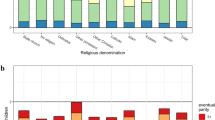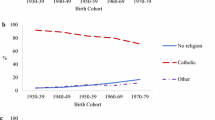Abstract
In the United States, the baby boom-era pattern of high Catholic and low Protestant fertility has ended. Among non-Hispanic whites in the 1980s, Catholic total fertility rates (TFRs) were about one-quarter of a child lower than Protestant rates (1.64 vs. 1.91). Most of the Protestant-Catholic difference is related to later and less frequent marriage among Catholics. Future research on the demography of religious groups should focus on explaining the delayed marriage pattern of Catholics, the high fertility of Mormons and frequently attending Protestants, and the very low fertility of those with no religious affiliation.
Similar content being viewed by others
References
Bachrach, Christine, Marjorie Hom, William Mosher, and Iris Shimizu. 1985. “National Survey of Family Growth, Cycle III: Sample Design, Weighting, and Variance Estimation.” Vital and Health Statistics Series 2, No. 98. Hyattsville, MD: National Center for Health Statistics.
Cornwall, Marie, Stan Albrecht, Perry Cunningham, and Brian Pitcher. 1986. “The Dimensions of Religiosity: A Conceptual Model with an Empirical Test.” Review of Religious Research 27(3):226–44.
Della Pergola, Sergio. 1980. “Patterns of American Jewish Fertility.” Demography 17(3):261–73.
Freedman, Ronald, Pascal Whelpton, and Arthur Campbell. 1959. Family Planning, Sterility, and Population Growth. New York: McGraw-Hill.
Gallup, George, Jr., and Sarah Jones. 1989. One Hundred Questions and Answers: Religion in America. Princeton: Princeton Religion Research Center.
Goldscheider, Calvin. 1967. “Fertility of the Jews.” Demography 4(1):196–209.
— 1971. Population, Modernization, and Social Structure. Boston: Little, Brown.
Goldscheider, Calvin and William Mosher. 1991. “Patterns of Contraceptive Use in the United States: The Importance of Religious Factors.” Studies in Family Planning 22(2):102–15.
Goldscheider, Calvin and Peter Uhlenberg. 1969. “Minority Group Status and Fertility.” American Journal of Sociology 74:361–72.
Heaton, Tim 1986. “How Does Religion Influence Fertility? The Case of Mormons.” Journal for the Scientific Study of Religion 25(2):248–58.
Heaton, Tim and Sandra Calkins. 1983. “Family Size and Contraceptive Use Among Mormons: 1965–1975.” Review of Religious Research 25(2):103–14.
Hout, Michael and Andrew Greeley. 1987. “The Center Doesn’t Hold: Church Attendance in the United States, 1940–1984.” American Sociological Review 52:325–45.
Judkins, David, William Mosher, and Steven Botman. 1991. “National Survey of Family Growth: Design, Estimation, and Inference.” Vital and Health Statistics, Series 2, No. 109. Hyattsville, MD: National Center for Health Statistics.
Kahn, Joan, Ronald Rindfuss, and David Guilkey. 1990. “Adolescent Contraceptive Method Choices.” Demography 27(3):323–36.
Marcum, John. 1981. “Explaining Fertility Differences among US Protestants.” Social Forces 60(2):532–43.
—. 1986. “Explaining Protestant Fertility: Belief, Commitment, and Homogamy.” Sociological Quarterly 27(4):547–58.
—. 1988. “Religious Affiliation, Participation, and Fertility: A Cautionary Note.” Journal for the Scientific Study of Religion 27(4):621–29.
Mosher, William and Gerry Hendershot. 1984a. “Religion and Fertility: A Replication.” Demography 21:185–91.
—. 1984b. “Religious Affiliation and the Fertility of Married Couples.” Journal of Marriage and the Family 46:671–77.
Mosher, William, David Johnson, and Marjorie Hom. 1986. “Religion and Fertility in the United States: The Importance of Marriage Patterns and Hispanic Origin.” Demography 23(3):367–79.
Mosher, William and James McNally. 1991. “Contraceptive Use at First Premarital Intercourse: United States, 1965–1988.” Family Planning Perspectives 23(3):108–16.
O’Connell, Martin and Carolyn Rogers. 1983. “Assessing Cohort Birth Expectations Data from the Current Population Survey, 1971–1981.” Demography 20:369–84.
Pratt, William, William Mosher, Christine Bachrach, and Marjorie Hom. 1984. “Understanding U.S. Fertility.” Washington, DC: Population Reference Bureau.
Ryder, Norman and Charles Westoff. 1971. Reproduction in the United States: 1965. Princeton: Princeton University Press.
Thornton, Arland. 1979. “Religion and Fertility: The Case of Mormonism.” Journal of Marriage and the Family 41:131–42.
U.S. Bureau of the Census. 1983. 1980 Census of Population, Vol. I. Chapter A. “Number of Inhabitants, Part I, U.S. Summary.” Table 8, pp. 1–43. Washington, DC: US Government Printing Office.
Westoff, Charles and Elise Jones. 1979. “The End of ‘Catholic’ Fertility.” Demography 16:209–18.
Westoff, Charles, Robert Potter, and Phillip Sagi. 1964. “Some Selected Findings of the Princeton Fertility Study, 1963.” Demography 1:130–35.
Whelpton, Pascal, Arthur Campbell, and John Patterson. 1966. Fertility and Family Planning in the United States. Princeton: Princeton University Press.
Williams, Linda and Basil Zimmer. 1990. “The Changing Influence of Religion on U.S. Fertility: Evidence from Rhode Island.” Demography 27(3):475–81.
Author information
Authors and Affiliations
Additional information
The 1982 and 1988 National Surveys of Family Growth were planned and funded jointly by the National Center for Health Statistics, the Office of Population Affairs, and the National Institute of Child Health and Human Development, all of the U.S. Department of Health and Human Services. This is a revised version of a paper presented at the annual meeting of the Society for the Scientific Study of Religion held in Virginia Beach in November 1990. The opinions expressed in this paper are solely those of the authors, and not necessarily those of any of the above agencies. The authors acknowledge the helpful comments of the anonymous reviewers and the editor of Demography on a previous draft. We dedicate this article to the memory of the late Basil G. Zimmer and the late Donald L. Mosher.
Rights and permissions
About this article
Cite this article
Mosher, W.D., Williams, L.B. & Johnson, D.P. Religion and fertility in the United States: New patterns. Demography 29, 199–214 (1992). https://doi.org/10.2307/2061727
Issue Date:
DOI: https://doi.org/10.2307/2061727




